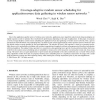463 search results - page 12 / 93 » Cross-Layer Design for Energy Conservation in Wireless Senso... |
TON
2010
13 years 2 months ago
2010
Abstract--Energy efficiency is critical for wireless sensor networks. The data-gathering process must be carefully designed to conserve energy and extend network lifetime. For appl...
INFOCOM
2011
IEEE
12 years 11 months ago
2011
IEEE
—For energy conservation, a wireless sensor network is usually designed to work in a low-duty-cycle mode, in which a sensor node keeps active for a small percentage of time durin...
COMCOM
2006
13 years 7 months ago
2006
Due to the application-specific nature of wireless sensor networks, application-aware algorithm and protocol design paradigms are highly required in order to optimize the overall ...
SENSYS
2004
ACM
14 years 1 months ago
2004
ACM
We propose B-MAC, a carrier sense media access protocol for wireless sensor networks that provides a flexible interface to obtain ultra low power operation, effective collision a...
AINA
2006
IEEE
14 years 1 months ago
2006
IEEE
In query-based wireless sensor networks (WSNs), the system must perform data sensing and retrieval and possibly aggregate data as a response at runtime. Since a WSN is often deplo...

